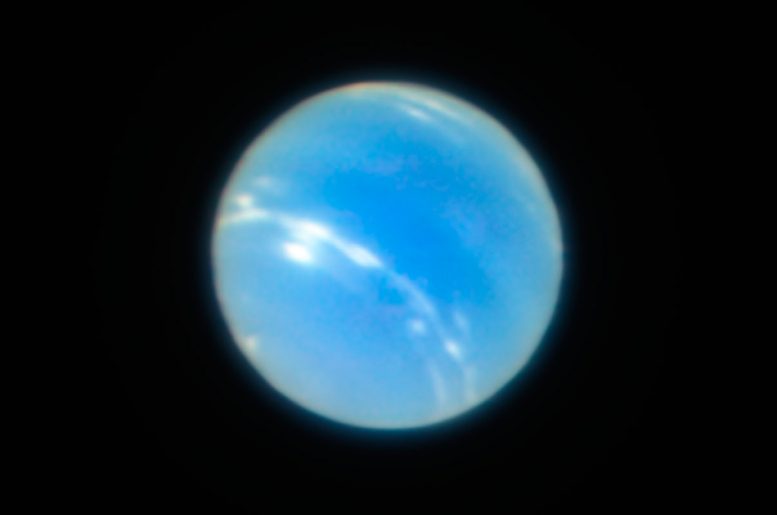
This image of the planet Neptune was obtained during the testing of the Narrow-Field adaptive optics mode of the MUSE/GALACSI instrument on ESO’s Very Large Telescope. The corrected image is sharper than a comparable image from the NASA/ESA Hubble Space Telescope. Credit: ESO/P. Weilbacher (AIP)
ESO’s Very Large Telescope (VLT) has achieved first light with a new adaptive optics mode called laser tomography — and has captured remarkably sharp test images of the planet Neptune, star clusters and other objects. The pioneering MUSE instrument in Narrow-Field Mode, working with the GALACSI adaptive optics module, can now use this new technique to correct for turbulence at different altitudes in the atmosphere. It is now possible to capture images from the ground at visible wavelengths that are sharper than those from the NASA/ESA Hubble Space Telescope. The combination of exquisite image sharpness and the spectroscopic capabilities of MUSE will enable astronomers to study the properties of astronomical objects in much greater detail than was possible before.
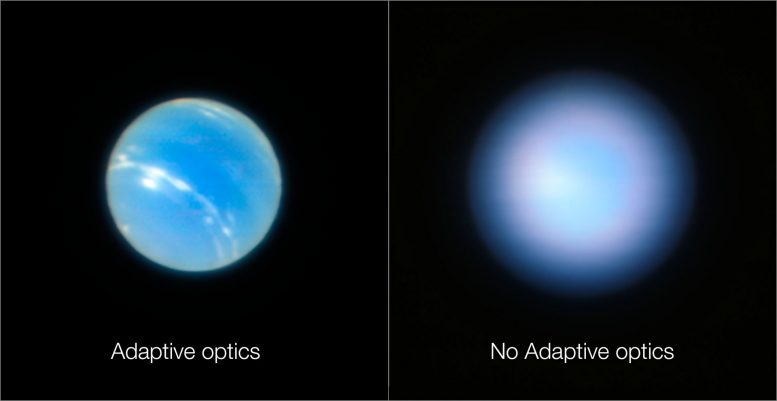
These images of the planet Neptune were obtained during the testing of the Narrow-Field adaptive optics mode of the MUSE/GALACSI instrument on ESO’s Very Large Telescope. The image on the right is without the adaptive optics system in operation and the one on the left after the adaptive optics are switched on. Credit: ESO/P. Weilbacher (AIP)
The MUSE (Multi Unit Spectroscopic Explorer) instrument on ESO’s Very Large Telescope (VLT) works with an adaptive optics unit called GALACSI. This makes use of the Laser Guide Star Facility, 4LGSF, a subsystem of the Adaptive Optics Facility (AOF). The AOF provides adaptive optics for instruments on the VLTs Unit Telescope 4 (UT4). MUSE was the first instrument to benefit from this new facility and it now has two adaptive optics modes — the Wide Field Mode and the Narrow Field Mode.
The MUSE Wide Field Mode coupled to GALACSI in ground-layer mode corrects for the effects of atmospheric turbulence up to one kilometer above the telescope over a comparatively wide field of view. But the new Narrow Field Mode using laser tomography corrects for almost all of the atmospheric turbulence above the telescope to create much sharper images, but over a smaller region of the sky.
ESO’s Very Large Telescope (VLT) has achieved first light with a new adaptive optics mode called laser tomography — and has captured remarkably sharp test images of the planet Neptune, star clusters and other objects. The pioneering MUSE instrument in Narrow-Field Mode, working with the GALACSI adaptive optics module, can now use this new technique to correct for turbulence at different altitudes in the atmosphere. It is now possible to capture images from the ground at visible wavelengths that are sharper than those from the NASA/ESA Hubble Space Telescope. The combination of exquisite image sharpness and the spectroscopic capabilities of MUSE will enable astronomers to study the properties of astronomical objects in much greater detail than was possible before. Credit: ESO
With this new capability, the 8-meter UT4 reaches the theoretical limit of image sharpness and is no longer limited by atmospheric blur. This is extremely difficult to attain in the visible and gives images comparable in sharpness to those from the NASA/ESA Hubble Space Telescope. It will enable astronomers to study in unprecedented detail fascinating objects such as supermassive black holes at the centers of distant galaxies, jets from young stars, globular clusters, supernovae, planets and their satellites in the Solar System and much more.
Adaptive optics is a technique to compensate for the blurring effect of the Earth’s atmosphere, also known as astronomical seeing, which is a big problem faced by all ground-based telescopes. The same turbulence in the atmosphere that causes stars to twinkle to the naked eye results in blurred images of the Universe for large telescopes. Light from stars and galaxies becomes distorted as it passes through our atmosphere, and astronomers must use clever technology to improve image quality artificially.
To achieve this four brilliant lasers are fixed to UT4 that project columns of intense orange light 30 centimeters in diameter into the sky, stimulating sodium atoms high in the atmosphere and creating artificial Laser Guide Stars. Adaptive optics systems use the light from these “stars” to determine the turbulence in the atmosphere and calculate corrections one thousand times per second, commanding the thin, deformable secondary mirror of UT4 to constantly alter its shape, correcting for the distorted light.
This sequence starts with a wide view of the Milky Way and zooms in on the globular star cluster NGC 6388 in the constellation of Scorpius (The Scorpion). The final images are first from MUSE on ESO’s Very Large Telescope in Wide Field Mode and then the last, very sharp, image shows part of the cluster using the MUSE Narrow Field Mode with adaptive optics turned on. Credit: ESO/S. Kammann (LJMU)/ N. Risinger (skysurvey.org). Music: Astral Electronic
MUSE is not the only instrument to benefit from the Adaptive Optics Facility. Another adaptive optics system, GRAAL, is already in use with the infrared camera HAWK-I. This will be followed in a few years by the powerful new instrument ERIS. Together these major developments in adaptive optics are enhancing the already powerful fleet of ESO telescopes, bringing the Universe into focus.
This new mode also constitutes a major step forward for the ESO’s Extremely Large Telescope, which will need Laser Tomography to reach its science goals. These results on UT4 with the AOF will help to bring ELT’s engineers and scientists closer to implementing similar adaptive optics technology on the 39-meter giant.

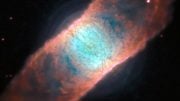

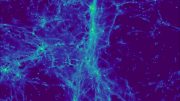
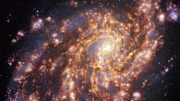
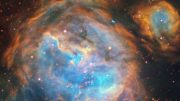

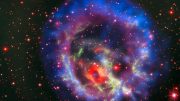

Looks like pure magic unless once accept that it is all wavelength analysis and high speed computational power of genetic algorithms. Then I think it is a brilliant solution to a huge vision problem. Can wait to see these methods applied to human vision to correct problems like blurred vision and perhaps eliminate all together all catarats and other illnesses of the eye that today have no solution. Science is great
Can this technology be scaled down to vastly improve the optics of consumer level telescopes??? I’m keenly interested if so.